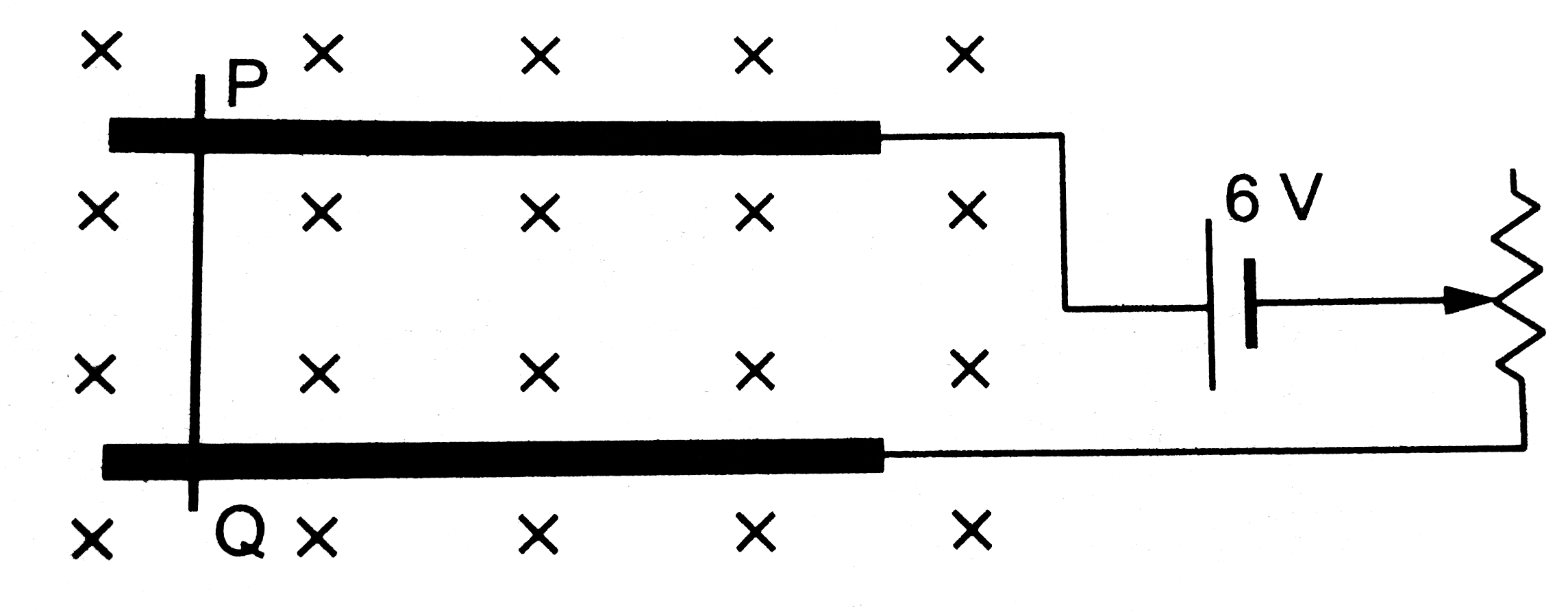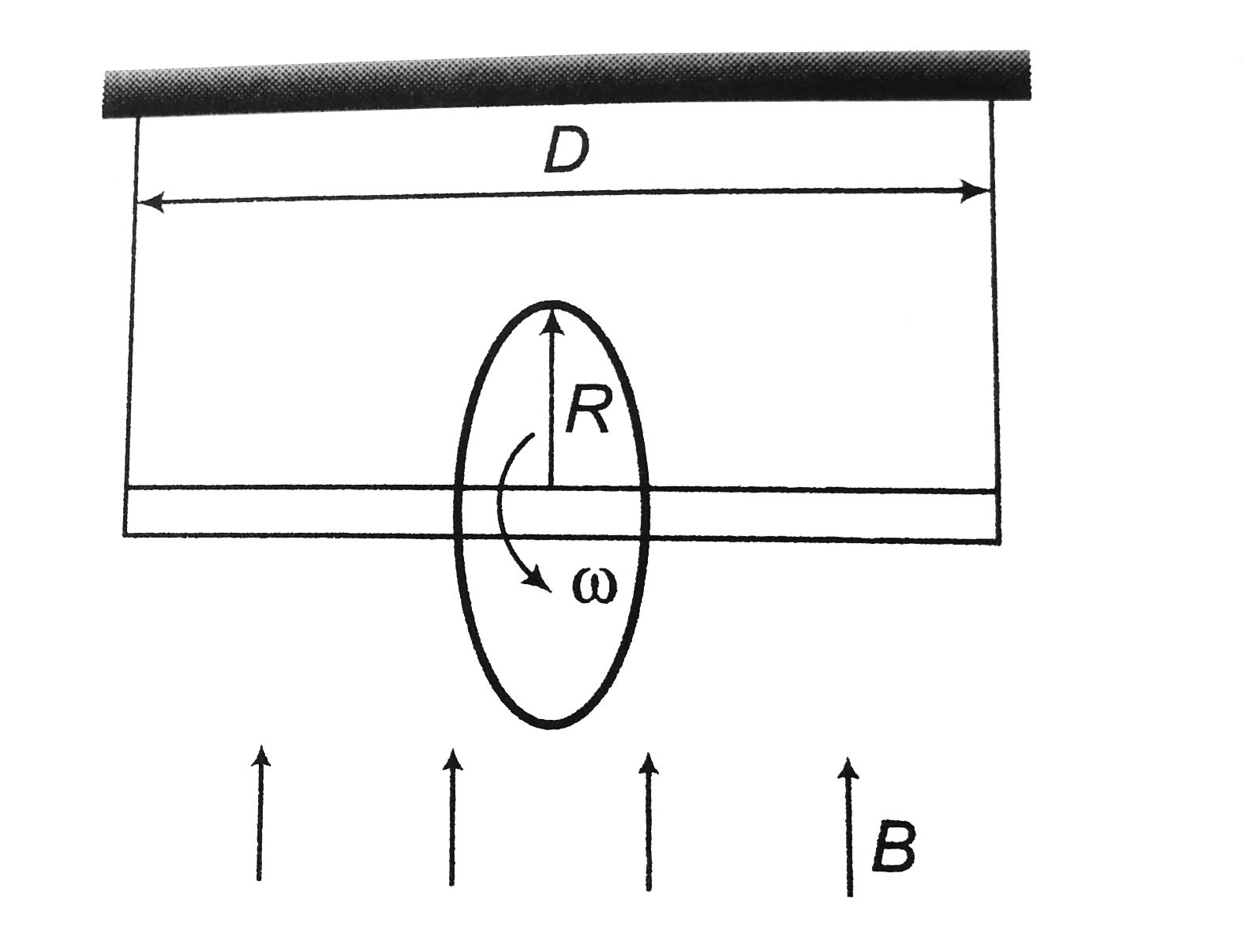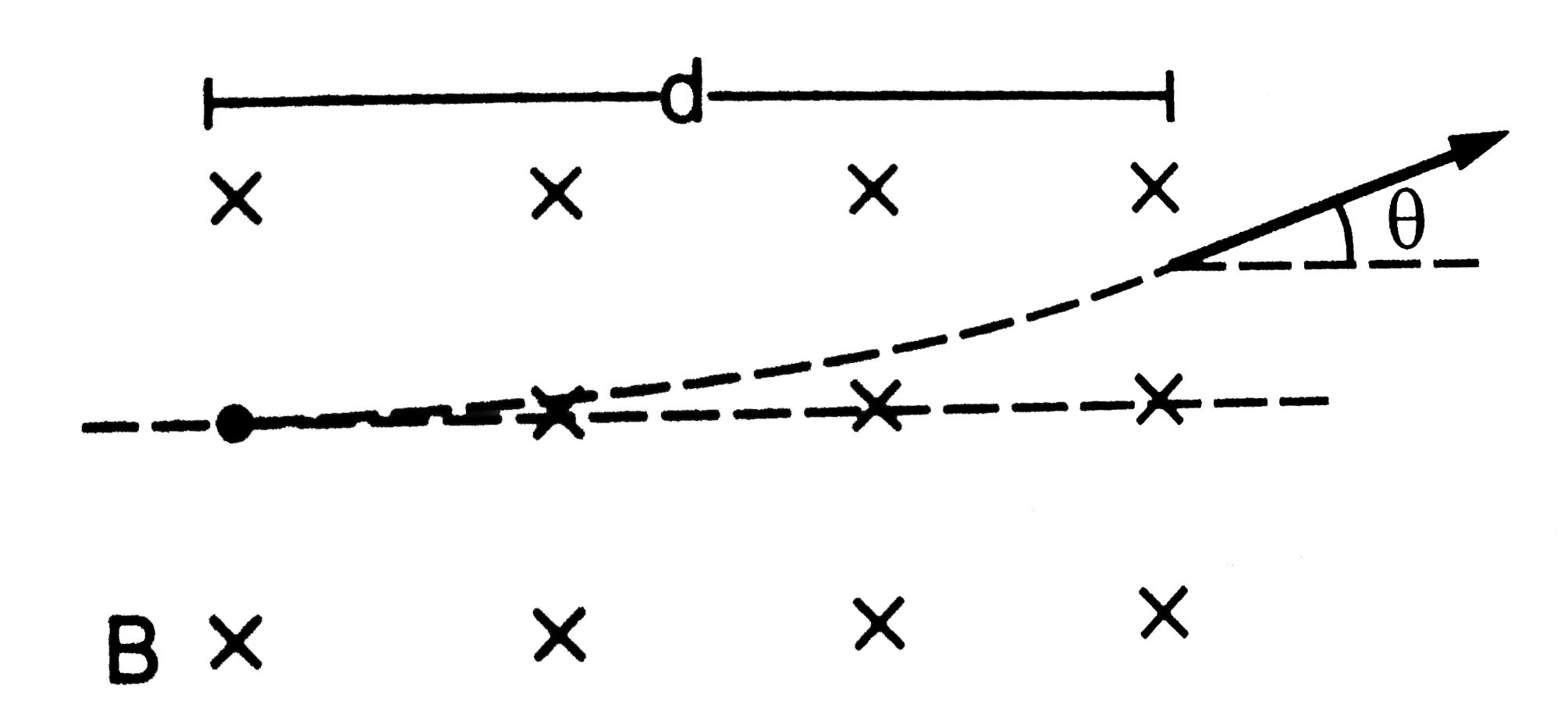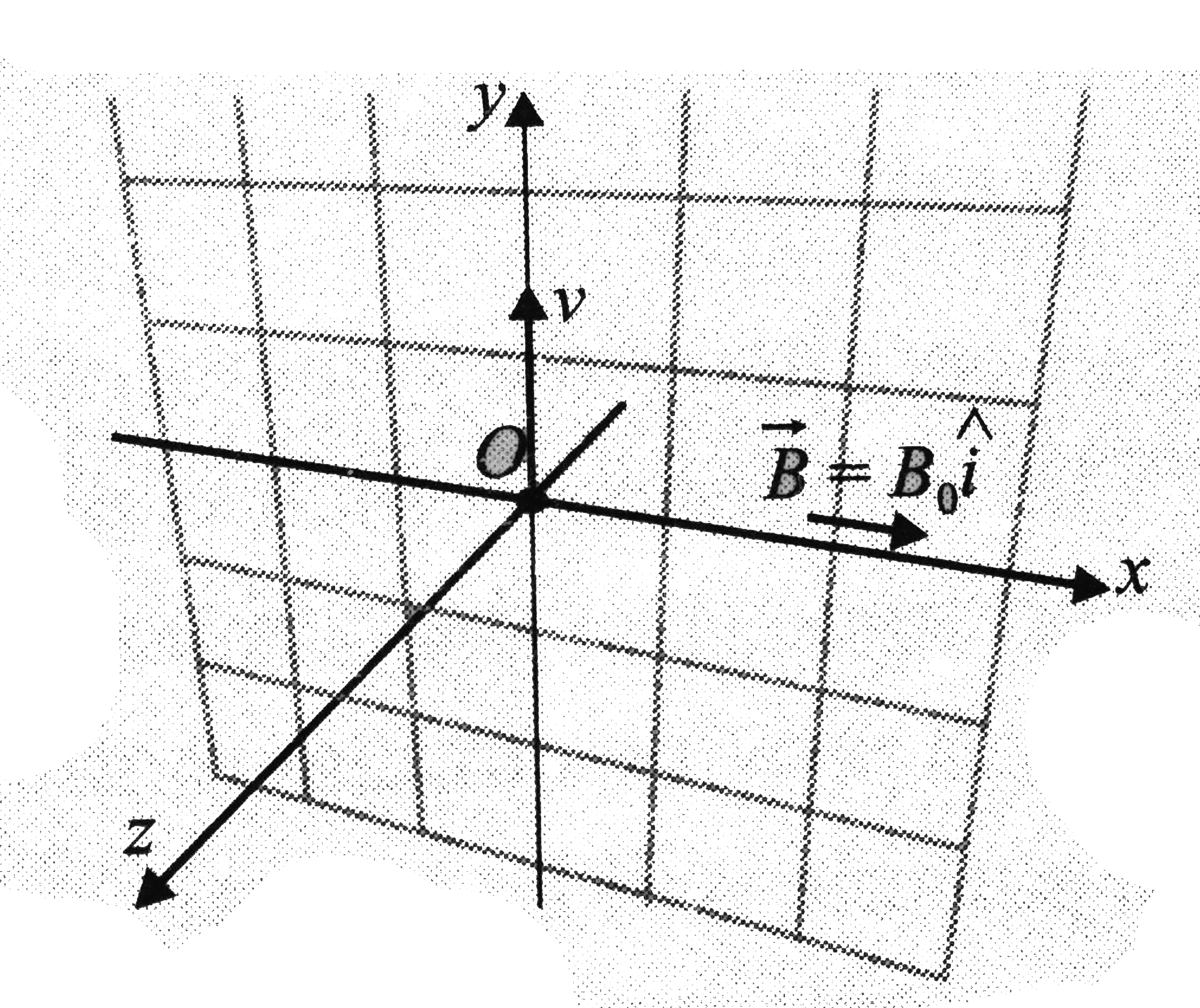Illustration from CENGAGE PHYSICS (ENGLISH) MAGNETIC FIELD AND MAGNETIC FORCES for Class 12
| Class 12 | PHYSICS |
| Chapter | MAGNETIC FIELD AND MAGNETIC FORCES |
| CENGAGE PHYSICS (ENGLISH) | Illustration |
| Medium | English |
| Academic Year | 2023-2024 |
Question 3
Doubly ionized helium ions are projected with a speed of 10kms−1 in a direction perpendicular to a uniformmagnetic field of magnitude 1.0 T. Find (a) the force acting on an ion, (b) the radius of the circle in which it ciruclates and ( c) the time taken by an ion to complete the circle.View SolutionQuestion 4
A stream of protons and deuterons in a vacuum chamber enters a uniform magnetic field. Both protons and deuterons have been subjected to same accelerating potential, hence the kinetic energies of the particles are the same. If the ion-stream is perpendicular to the magnetic field and the protons move in a circular path of radius 15 cm, find the radius of the path traversed by the deuterons. Given that mass of deuteron is twice that of a proton.View SolutionQuestion 7
A charged particle of mass m and charge q is accelerated through a potential difference of V volts. It enters a region of uniform magnetic field which is directed perpendicular to the direction of motion of the particle. Find the radius of circular path moved by the particle in magnetic field.View SolutionQuestion 8
A beam of charged particle, having kinetic energy 103eV, contains masses 8×10−27kgand1.6×10−26kg emerge from the end of an accelerator tube. There is a plate at distance 102m from the end of the tube and placed perpendicular to the beam. Calculate the magnitude of the smallest magnetic field which can prevent the beam from striking the plate.View SolutionQuestion 14
An electron accelerated by a potential difference 2.5 kV moves horizontally into a region of space in which there is a downward directed uniform electric field of magnitude 10kVm−1.
(a) In what direction must a magnetic field be applied so that the electron moves undeflected? Ignore the gravitational force. What is the magnitude of the smallest magnetic field possible in this case?
(b) What happens if the charge is a proton that passes through the same combination of fields ?View SolutionQuestion 15
A proton beam passes without deviation through a region of space, where there are uniform tranverse mutully perpendicular electric and magnetic field with E = 220 kV/m and B = 50 mT.Then the beam strikes a grounded target.Find the force imparted by the beam on the target, if beam current is equal to i = 0.80 mA View SolutionQuestion 16
A mass spectrometer separates ions according to their ratio of charge to mass. Such devices are widely used in silence and engineering to analyze unknown mixtures and to separate isotopes of chemical elements. Figure 1.24 shows ions of charge q and mass m first being accelerated from rest through a potential difference V and then entering a region of uniform magnetic field B pointing out of the page. Only the magnetic force acts on the ions in this region, so they undergo circular motion and, after half an orbit, land on a detector. Find an expression for the horizontal distancexxfrom the entrance slit to the point where an ion lands on the detector.
 View Solution
View SolutionQuestion 18
A matel wire PQ of mass 10g lies at rest on two horizontal metal rails separated by 4.90 cm . A vertically downward magnetic field of magnitude 0.800 T exists in the space. The resistance of the circuit is slowly decreased and it is found that when the resistance goes below20.0Ω, the wire PQ starts sliding on the rails. Find the coefficient of friction.
 View Solution
View SolutionQuestion 19
Shows a rod PQ of length 20.0 cm and mass 200g suspended through a fixed point O by two threads of lengths 20.0 cm each. A magnetic field of strenght 0.500 T exists in the vicinity of the wire PQ as shown in the figure. The exists in the vicinity of the wire PQ as shown in the figure. The wires conecting PQ with the battery are loose and exert no force on PQ.(a) find the tension in the threads when the switch S is open. (b) A current of 2.0 A is established when the switch S is closed. Find the tension in the threads now.
 View Solution
View SolutionQuestion 23
A hypthetical magnetic field existing in a region is given by →B=B0→er, where →–––r denotes the uit vector along the redial direction. A circular loop of radus a, carrying a current I, is placed with its plane parallel to the x-y plane and the centre at (0,0, d) .Find the magnitude of the magnetic force acting on the loop.View SolutionQuestion 24
A conducting wire of length l is placed on a rough horizontal surface, where a uniform horizontal magnetic field B perpendicular to the length of the wire exists. Least values of the forces required to move the rod when a current I is established in the rod are observed to be F1 and F2(<F1) for the two possible directions of the current through the rod, respectively. Find the weight of the rod and the coefficient of friction between the rod and the surface.View SolutionQuestion 31
A coil in the shape of an equilateral triangle of side 0.02 m is suspended from a vertex such that it is hanging in a vertical plane between the pole pieces of a permanent magnet producing a horizontal magnetic field of 5×10−2T. Find the couple acting on the coil when a current of 0.1 A is passed through it and the magnetic field is parallel to its plane.View SolutionQuestion 33
A wire is wrapped N times over a solid sphere of mass m which is place on a smooth horizontal surface. A horizontal magnetic field of induction →B is present. Find the (a) torque (b) angular acceleration experienced by the sphere. Assume that the mass of the wire is negligible compared to the mass of the sphere.
 View Solution
View SolutionQuestion 35
A rectangular coil of area 5.0×10−4m2 and 60 turns is pivoted about one of its vertical sides. The coil is in a radial horizontal field of 90 G (radial here means the field liners are in the plane of the coil for any rotation). What is the torsional constant of the hair spring connected to the coil if a current of 2.0 mA produces an angular deflection of 18∘?View SolutionQuestion 36
The coil of a galvanometer is 0.02×0.8m2. It consists of 200 turns of the wire and is in a magnetic field of 0.20 T. The restoring torque constant of suspension fibre is 10−5Nm/degree. Assuming magnetic field to be radial
(a) What is the maximum current that can be measured by this galvanometer if scale can accommodate 45∘ deflection?
(b) What is the smallest current that can be detected if minimum observed deflection is 0.1∘?View SolutionQuestion 37
A potential difference of 600vo<s is applied across the plates of a parallel plate consenser . The separation between the plates is 3mm. An electron projected vertically, parallel to the plates , with a velocity of 2×106m/sec moves underflected between the plates. Find the magnitude and direction of the magnetic field in the region between the condenser plates. ( Neglect the edge effects). ( Charge of the electron = -1.6xx10^(-19) coulomb)
 View Solution
View SolutionQuestion 38
A particle of mass 1×10−26kg and charge +1.6×10−19C travelling with a velocity 1.28×106ms−1 in the +x direction enters a region in which uniform electric field E and a uniform magnetic field of induction B are present such that Ex=Ey=0,Ez=−102.4kVm−1,andBx=Bz=0,By=8×10−2. The particle enters this region at time t=0. Determine the location (x,y,z coordinates) of the particle at t=5×10−6s. If the electric field is switched off at this instant (with the magnetic field present), what will be the position of the particle at t=7.45×10−6s ?View SolutionQuestion 39
A particle of mass m and charge +q enters a region of magnetic field with a velocity v, as shown in Fig. 1.93.
a. Find the angle subtended by the circular arc described by it in the magnetic field.
b. How long does the particle stay inside the magnetic field?
c. If the particle enters at E, what is the intercept EF?
 View Solution
View SolutionQuestion 41
An electron gun G emits electons of energy 2keV travelling in the positive x-direction. The electons are required to hit the spot S where GS=0.1m, and the line GS makes an angle of 60∘ with the x-axis as shown in figure. A uniform magnetic field B parallel to GS exists in the region outside the electron gun.

find the minimum value of B needed to make the electrons hit S.View SolutionQuestion 42
An electron in the ground state of hydrogen atom is removing in unanticlockwise direction in a circle orbit of radius R

a. Obtain an expression for the orbital magnetic dipole moment of the electron .
b. The atom is placed in a uniform magnetic indution ¯¯¯B such that the plane normal to the electron orbitmakes an angle of 30∘ with the magnetic induction. Find the tarque experienced by the orbiting electron .View SolutionQuestion 43
A particle of mass m and charge q is moving in a region where uniform, constant electric and mangetic fields →Eand→B are present. →Eand→B are parallel to each other. At time t=0, the velocity →v0 of the particle is perpendicular to →E (Assume that its speed is always <<c, the speed of light in vacuum). Find the velocity →v of the particle at time t. You must express your answer in terms of t,q,m, the vector →v0,→E and →B and their magnitudes →v0,→E and →B.View SolutionQuestion 44
A uniform constant magnetic field B is directed at an angle of 45∘ to the xaξs in the xy- plane . PQRS is a rigid, square wire frame carrying a steady current I0, with its centre at the origin O. At time t=0, the frame is at rest in the position as shown in figure , with its sides parallel to the xandy axis. Each side of the frame is of mass M and length L.
(a) What is the torque τ about O acting on the frame due to the magnetic field?
(b) Find the angle by which the frame rotates under the action of this torque in a short interval of time Δt, and the axis about this rotation occurs .(Δtissoshorttˆanyvariation∈the→rquedur∈gthis∫ervalmaybe¬≤cted.)Given:themomentof∫eriaoftheameaboutanaξsthroughitscentreperpendica––r→itsaboutanaξsthroughitscentreperpendica––r→itspla≠is(4)/(3) ML^(2).
 View Solution
View SolutionQuestion 45
The region between x=0 and x=L is filled with uniform steady magnetic field B0ˆk. A particle of mass m, positive charge q and velocity v0ˆi travels along x-axis and enters the region of the magnetic field. Neglect the gravity throughout the question.
a. Find the value of l if the particle emerges from the region of magnetic field with its final velocilty at an angel 30∘ to its initial velocity.
b. Find the final velocity of the particle and the time spent by it in the magnetic field, if themagnetic field now extends upto 2.1L.View SolutionQuestion 46
A rectangular loop PQRS made from a uniform wire has length a, width b and mass m.It is free to rotate about the arm PQ which remasins hinged along a horizontal line taken as the y-axis (see figure). Take the vertically upward direction as the z-axis. A uniform magnetic fiedl B=(3ˆi+3ˆk)B0 exists in the region. The lop is held in the xy-plane and a current I is passed through it. The loop in now released and is found to stay in the horizontal position in equilibrium.

a. What is the direction of the current I in PQ?
b. Find the magnetic force on the arm RS.
c. Find the expression for I in terms of B0, a, bandm.View SolutionQuestion 47
A ring of radius R having uniformly distributed charge Q. is mounted on a rod suspended by two identical strings. The tension in strings in equilibrium is T0. Now, a vertical magnetic field is switched on and ring is rotated at constant angular velocity co. Find the maximum value of co h which the ring can be rotated if the strings can withstand a maximum tension of 3T02
 View Solution
View SolutionQuestion 48
In a moving coil galvanometer, torque on the coil can be experessed as τ=ki, where i is current through the wire and k is constant . The rectangular coil of the galvanometer having number of turns N , area A and moment of interia I is placed in magnetic field B. Find
(a) k in terms of given parameters N,I,AandB
(b) the torsion constant of the spring , if a current i0 produces a deflection of (π)/(2) in the coil .
(c) the maximum angle through which the coil is deflected, if charge Q is passed through the coil almost instaneously. ( ignore the daming in mechinal oscillations).View SolutionQuestion 49
A slightly divergent beam of charged particles accelerated by a Potential difference V propogates from a point A along the axis of a solenoid. The beam is brought into focus at a distance l from the point A at two successive values of magnetic induction B1andB2. Find the specific charge q/m of the particles.View SolutionQuestion 50
A small charged ball having mass m and charge q is suspended from a rigid support by means of an inextensible thread of length l. It is made to rotate on a horizontal circular path in a uniform, time independent magnetic field of induction B which is directed upward. The time period of revolution of the ball is T0. If the thread is always stretched, calculate the radius of circular path on which the ball moves.View SolutionQuestion 51
Non-relativistic protons move reactilinearly in the region of space where there are uniform mutually perpendicular electric and magnetic fields with E and B. The trajectory of the protons lie in the plane X-Y as shown in Fig. 1.107 and forms an angle ϕ with X-axis. Find the pitch of the helical trajectory along which the protons will move after the electric field is switched off.
 View Solution
View SolutionQuestion 52
A current i, indicated by the crosses in figure, is established in a strip of copper of height h and width w. A uniform field of magnetic induction B is applied at right angle to the strip.
(a) Calculate the drift velocity vd of the electrons.
(b) What are the magnitude and direction of the magnetic force F acting on the electrons?
(c) What should the magnitude and direction of a homogeneous electric field E be in order to counterbalance the effect of mangetic field?
(d) Calculate voltage V necessary between two sides of the conductor in order to creat this field E Between which sides of the conductor would this voltage have to be applied?
(e) If no electric field is applied from the outside, the electrons will be pushed somewhat to one side and therefore will give rise to a uniform electric field EH across the conductor until the forces of this electrostatic field EH balance the magnetic forces encountered in part (b). What will be the magnitude and direction of field EH?
Assume that n, the number of conductor electrons per unit volume is 1.1×1029m−3,h=0.02m,w=0.1cm,i=50A,andB=2T.
 View Solution
View SolutionQuestion 53
A straight conductor of weight 1 N and length 0.5 m, is located in a plane making an angle 30∘ with the horizontal so that it is perpendicular to a uniform mangetic field of induction B=0.109T. Given that the conductor carries a current of 10 A away from the reader, and coefficient of static friction is 0.1, find the force needed to be applied parallel to the plane to sustain the conductor at rest.View SolutionQuestion 54
There is a constant homogeneous electric field of 100Vm−1 within the region x=0andx=0.167m pointing in x-direction. There is a constant homogeneous mangetic field B within the region x=0.167mandx=0.334m pointing in the z-direction. A proton at rest at the origin is released in positive x-direction. Find the minimum strength of the magnetic field B, so that the proton is detected back at x=0,y=0.167m. (mass of proton =1.67×10−27kg)View SolutionQuestion 55
A positively charged particle of mass m and charge q is projected on a rough horizontal x-y plane surface with z-axis in the vertically upward direction. Both electric and magnetic fields are acting in the region and given by →E=−E0ˆkand→B=−B0ˆk , respectively. The particle enters into the field at (a0,0,0) with velocity →v=v0ˆj. The particle starts moving in some curved path on the plane. If the coefficient of friction between the particle and the plane is μ. Then calculate the
(a) time when the particle will come to rest
(b) distance travelled by the particle when it comes to rest.
 View Solution
View SolutionQuestion 56
A loop of flexible conducting wire of length 0.5 m lies in a magnetic field of 1.0 T perpendicular to the plane of the loop. Show that when a current as shown in Fig. 1.112 is passed through the loop, it opens into a circle. Also calculate the tension developed in the wire if the current is 1.57 A.
 View Solution
View SolutionQuestion 57
A circular coil of 100 turns has an effective radius of 0.05 m and carries a current of 0.1 A. How much work is required to turn it in an external magnetic field of 1.5Wbm−2 through 180∘ about an axis perpendicular to the magnetic field. The plane of the coil is initially perpendicular to the magnetic field.View SolutionQuestion 58
A positively charged particle of charge 1C and mass 40g, is revolving along a circle, of radius 40cm with velocity 5ms in a uniform magnetic field with centre at origin 0 in xy-plane. At t=0, the particle was at (0,0.4m,0) and velocity was directed along positive x-direction. Another particle having charge 1C and mass 10g moving uniformly parallel to z-direction 40 with velocity 40πmscollides with revolving particle at t=0 andgets stuck with it. Neglecting 7C gravitational force and colombians force, calculate x,y and z-coordinates of the combined particle at t=π40secView SolutionQuestion 59
An electron accelerated by a potential difference V=3 volt first enters into a uniform electric field of a parallel plate capacitor whose plates extend over a length l=6cm in the direction of initial velocity. The electric field is normal to the direction of initial velocity and its strength varies with time as E=αt, where α=3600Vm−1s−1. Then the electron enters into a uniform magnetic field of induction B=π×10−9T. Direction of magnetic field is same as that of the electric field. Calculate pitch of helical path traced by the electron in the magnetic field. (Mass of electron, m=9×10−31kg)View Solution
All Exercises from CENGAGE PHYSICS (ENGLISH) Class 12 PHYSICS MAGNETIC FIELD AND MAGNETIC FORCES
- ARCHIVES ASSERTION-REASION
- ARCHIVES COMPREHENSION
- ARCHIVES FILL IN THE BLANK
- ARCHIVES INTEGER
- ARCHIVES MULTIPLE CORRECT
- ARCHIVES SINGLE CORRECT
- ARCHIVES TRUE /FALSE
- COMPHENSION BASED
- COMPREHENSION TYPE
- EXERCISE 1.1
- EXERCISE 1.2
- EXERCISE1.3
- EXERCISES ASSERTION -REASONING
- EXERCISES INTEGER
- EXERCISES LINKED COMPREHENSION
- EXERCISES MULTIPLE CORRECT
- EXERCISES SINGLE CORRECT
- EXERCISES SUBJECTIVE
- MULTIPLE
- MULTIPLE CORRECT ANSWER TYPE
- SINGLE CORRECT ANSWER TYPE
- SUBJECTIVE
- SUBJECTIVE TYPE
- ILLUSTRATION
- SOLVED EXAMPLE









